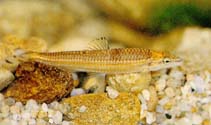http://www.fishbase.org/Summary/speciesSummary.php?genusname=Coreoleuciscus&speciesname=splendidus ---> http://192.134.151.83/Summary/speciesSummary.php?genusname=Coreoleuciscus&speciesname=splendidus
http://192.134.151.83/Summary/speciesSummary.php?genusname=Coreoleuciscus&speciesname=splendidus ---> https://fishbase.mnhn.fr/Summary/speciesSummary.php?genusname=Coreoleuciscus&speciesname=splendidus
https://fishbase.mnhn.fr/Summary/speciesSummary.php?genusname=Coreoleuciscus&speciesname=splendidus ---> https://fishbase.mnhn.fr/summary/Coreoleuciscus-splendidus.html
Coreoleuciscus splendidus

You can
sponsor
this page
Common name (e.g. trout)
Genus + Species (e.g. Gadus morhua)
-

-
About this page
-
Languages
-
User feedbacks
-
Citation
-
Uploads
-
Related species
-


 Upload your
photos
and
videos
Upload your
photos
and
videos
Pictures
|
Google image
 Coreoleuciscus splendidus
Coreoleuciscus splendidus
Picture by
Kim, I.-S.
Teleostei (teleosts) >
Cypriniformes
(Carps) >
Gobionidae
(Gudgeons)
Etymology:
Coreoleuciscus:
Greek, kore, -es = pupil and also with themenaing of "maid" + Greek, leykos = white (Ref.
45335
)
.
More on author:
Mori
.
Environment: milieu / climate zone / depth range / distribution range
Ecology
Freshwater; demersal. Temperate
Asia: South Korea.
Size / Weight / Age
Maturity: L
m
?
range ? - ? cm
Max length : 15.0 cm TL male/unsexed; (Ref.
12218
)
Vertebrae
: 39 - 40.
Coreoleuciscus splendidus
differs from its congener
C. aeruginos
by the following body coloration and shape and/or presence of black bands on dorsal, anal and caudal fin rays: golden line immediately above a luteous line that runs along a lateral line on side of body (vs. bluish-green line above the luteous line); bright yellow line immediately above a violet and bluish line running along lateral line on side body during spawning season (vs. a luteous line immediately above a black line present during the spawning season); dorsal fin with a thick and discontinuous distal band and a thick and continuous basal band (vs. with a thin and continuous band both distally and basally); anal fin with quite thick and long distal dark band and short basal band (vs. anal fin with thin and relatively short distal band and without basal band); caudal fin with seven bands in centrosymmetric structure, three pairs of six thin bands separated into two lobes at medial and distal-most areas and a thin basal band extending outwards (vs. caudal fin with with three stripes in centrosymmetric structure, a thick and continuously band distally across lobes, one pair of two thick bands separated into two lobes medially, and a thick and short one at the basal part (Ref.
100736
).
Life cycle and mating behavior
Maturity
|
Reproduction
|
Spawning
|
Eggs
|
Fecundity
|
Larvae
Chyung, M.-K.
, 1977. The fishes of Korea. Il Ji Sa Publishing Co. Seoul, Korea. 727 p. (Ref.
12218
)
IUCN Red List Status (Ref.
130435
)
Not Evaluated
CITES
Not Evaluated
Not Evaluated
Threat to humans
Harmless
Human uses
FAO - Publication:
search
|
FishSource
|
More information
Countries
FAO areas
Ecosystems
Occurrences
Introductions
Stocks
Ecology
Diet
Food items
Food consumption
Ration
Common names
Synonyms
Metabolism
Predators
Ecotoxicology
Reproduction
Maturity
Spawning
Spawning aggregation
Fecundity
Eggs
Egg development
Age/Size
Growth
Length-weight
Length-length
Length-frequencies
Morphometrics
Morphology
Larvae
Larval dynamics
Recruitment
Abundance
BRUVS
References
Aquaculture
Aquaculture profile
Strains
Genetics
Electrophoreses
Heritability
Diseases
Processing
Nutrients
Mass conversion
Collaborators
Pictures
Stamps, Coins Misc.
Sounds
Ciguatera
Speed
Swim. type
Gill area
Otoliths
Brains
Vision
Tools
E-book
|
Field guide
|
Length-frequency wizard
|
Life-history tool
|
Point map
|
Classification Tree
|
Catch-MSY
|
Special reports
Check for Aquarium maintenance
|
Check for Species Fact Sheets
|
Check for Aquaculture Fact Sheets
Download XML
Summary page
|
Point data
|
Common names
|
Photos
Internet sources
AFORO (otoliths) |
Aquatic Commons
|
BHL
|
Cloffa
|
BOLDSystems
|
Websites from users
|
Check FishWatcher
|
CISTI
|
Catalog of Fishes
:
genus
,
species
|
DiscoverLife
|
ECOTOX
| FAO - Publication:
search
|
Faunafri
| Fishipedia |
Fishtrace
| GenBank:
genome
,
nucleotide
| GloBI |
Google Books
|
Google Scholar
|
Google
| IGFA World Record |
MitoFish
|
Otolith Atlas of Taiwan Fishes
|
PubMed
| Reef Life Survey | Socotra Atlas |
Tree of Life
| Wikipedia:
Go
,
Search
| World Records Freshwater Fishing |
Zoobank
|
Zoological Record
Estimates based on models
Phylogenetic diversity index (Ref.
82804
): PD
50
= 0.7500 [Uniqueness, from 0.5 = low to 2.0 = high].
Bayesian length-weight: a=0.00617 (0.00389 - 0.00977), b=3.15 (3.02 - 3.28), in cm total length, based on LWR estimates for this species & (Sub)family-body (Ref.
93245
).
Trophic level (Ref.
69278
): 3.3 ±0.4 se; based on size and trophs of closest relatives
Resilience (Ref.
120179
): Medium, minimum population doubling time 1.4 - 4.4 years (Preliminary K or Fecundity.).
Fishing Vulnerability (Ref.
59153
): Low vulnerability (10 of 100).
Back to Search
Random Species
Back to Top
Accessed through:
Not available
FishBase mirror site :
localhost
Page last modified by :
mrius-barile
- 20 July 2016
Fatal error
: Uncaught ArgumentCountError: Too few arguments to function checkEcotox(), 1 passed in /var/www/html/summary/speciessummary.php on line 2304 and exactly 3 expected in /var/www/html/includes/speciessummary.lib.php:2579 Stack trace: #0 /var/www/html/summary/speciessummary.php(2304): checkEcotox() #1 {main} thrown in
/var/www/html/includes/speciessummary.lib.php
on line
2579
|